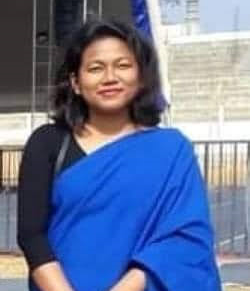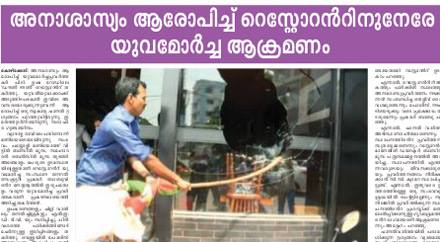Rakhee Naiding
 “Lama hemhishining jaya, lama slamma bo nangdu”
“Lama hemhishining jaya, lama slamma bo nangdu”
(It is not enough we tread the path, we have to create them too)- A Dimasa saying
Recently the Assam Assembly elections concluded, and the results were evidently a shock to many, especially after the anti CAA upheaval. All the same, people seem to have quickly accepted the verdict with farewell messages to former CM Sarbananda Sonowal celebrating his benevolence or the stories of a persevering Dr. Himanta Biswa Sarma, whose sole aim seems to have been to become the CM of Assam since his youth, taking up much space in media. The Third Front looks happy to bag the single Sibasagar seat with prominent activist Akhil Gogoi’s victory and attacking voters elsewhere for voting ‘fascists’.
In all of these developments, one of the most jarring blows to a liberal democratic society and social justice has come in the form of denying representation to Hills of Assam in the process of ministry allocation. The new Cabinet consists of 14 ministers and the CM, and in no manner, callous selection, representatives of various major communities of Assam have been accommodated. The hills seem to have missed that bus, in any case. The hill districts, Dima Hasao and Karbi Anglong find no representation in the new Cabinet of Chief Minister Sarma. The omission is glaring and is a grave deprivation for the peoples of the two districts. Additionally, the Hills Area Department (HAD) ministry has been given to Jogen Mohan, a non-ST Hills (STH) person who is not a native of either of the two hills districts. To add insult to injury, the electorate in both districts voted overwhelmingly (table attached) for the BJP candidates despite a vibrant campaign by Dima Hasao Congress candidate Nirmal Langthasa and his team in the Haflong constituency.
 (Table prepared from data sourced from eci.gov.in)
(Table prepared from data sourced from eci.gov.in)
Questions have been raised if the state government deems the hills representatives, 5 of them in all unfit to handle the affairs of their land and peoples. It is to be noted that the cabinet ministry of the HAD was set up distinctly to look after the administration of the Hills in conjunction with the Autonomous Councils of both districts.
Secondly, if HAD can be allocated to a non-hills MLA, allocation of a portfolio being the prerogative of the leader of the ruling party/alliance, can a hill MLA not head other important cabinet ministry or are they unfit for those ministries as well?
Thirdly, this assembly election was significant for Dima Hasao since it was for the first time a female candidate, Nandita Gorlosa, had won from the constituency from the BJP. Gorlosa earlier held an education portfolio in the autonomous district council and is known for her excellent work among all communities of the district. Dima Hasao had no MLA holding any ministry, cabinet or MoS (independent charge) since 15 years when Lt. G.C. Langthasa was elected for the fourth term as MLA from Dima Hasao from Indian National Congress and inducted as a cabinet minister in Tarun Gogoi ministry.
Fourthly, this time in Assam, only six women in total have been elected to the assembly. Only one woman, MLA Ajanta Neog of Golaghat constituency, is part of the current ministry. Among the 6 Gorlosa is the only female ST representative and the first female MLA from the hill tribes. Nevertheless, she finds no space in the ministry. Hills’ women have not had any representation in the Assembly or Parliament in recent times. The sole female MP from hill districts was Kabon Neli Timungpi, elected in the first Lok Sabha in 1952 from the hill districts. Between 1952 and 2021, there is a gap of almost seven decades, and yet the significance of a female being elected from a vulnerable and underrepresented community and deserving of representation is lost on all.
One may, of course, say that such an exclusion is not by design but the working of the machinations of real-time politicking and lobbying. However, this denial is hardly an isolated event. Such exclusion is a mainstay of the Assam’s politic since independence and its treatment of the hill districts have always been discriminatory and humiliating.
Hill Districts and Systemic Exclusion
In 1950 when the hill districts were formed on the principle of tribal autonomy, these districts were to be governed through the provisions of the Sixth Schedule of the Indian Constitution. The Sixth Schedule envisions autonomous district councils administering the hill areas and being run by elected representatives from among the hill tribes. From the very outset, the district councils of undivided Assam and their elected representatives pointed out the grave deficiencies in the provisions of autonomy as enshrined in the schedule. Lack of financial autonomy, bureaucratic control, and the interventionist approach of the state government were some of the factors highlighted. These grievances came to a head during the Assamese Language Movement, following which the Assamese Official Language Act was passed in October 1960 despite opposition from different linguistic groups, including hills leaders.
Fearing social and cultural annihilation clubbed with fears of political ignominy despite autonomous councils, in July 1960, the hills leaders of undivided Assam took a radical stance that of the formation of The All Party Hill Leaders’ Conference (APHLC) led by Williamson Sangma, then Chief Executive Member(CEM) of the Garo Hills district council. The main agenda of this political party was the formation of a hill state which would consist of all hill districts of the northeast region and include parts of other states in the region that had significant hill tribe population. This movement had the active participation of the leaders of present-day Karbi Anglong and Dima Hasao. The APHLC leadership stressed that “there was no adequate safeguard for the preservation of the identity, racial, linguistic and cultural, of the hill people in the Sixth Schedule; that the Sixth Schedule did not endow the district councils with adequate powers to safeguard their interests, social, economic and political. Further, the attitude of the people of the plains was one of hostility and contempt towards the tribals”.2 The movement ultimately led to the formation of Meghalaya state in 1972, which was earlier Garo and United Khasi and Jaintia hill districts.
Despite previously being part of the APHLC, the leadership of Karbi Anglong and Dima Hasao chose to remain with Assam based on assurance to grant greater autonomy made by the state as well as central government. It is also to be noted that even then, Karbi Anglong and Dima Hasao were weakest in terms of several developmental indices among the hill districts. The Naga, Lushei, Garo and United Khasi, and Jaintia Hills were better off due to different historical factors. A misleading religious argument, the “Christian conspiracy,” was also made to sway the leadership that Karbi Anglong and Dima Hasao tribes being predominantly Hindu, unlike the Christian tribes of the rest, would be better off with the Hindu peoples of the plains of Assam.
Thereafter, the twin district was bifurcated into two separate districts. More subjects were added to the constellation of powers and functions in the Sixth Schedule, and Article 244A was added to Sixth Schedule after the 22nd Amendment of 1969, which states the “Formation of an autonomous State comprising certain tribal areas in Assam and creation of local Legislature or Council of Ministers or both”3
Despite all these developments, the core issue of the lack of autonomy raised at the beginning by the APHLC leaders was never dealt with. The 70s saw the beginning of the Assam Movement, which, however, did not gain any stronghold in the hills. All the same, the upheaval in the Brahmaputra greatly affected them. Unrest in the plains practically chokes the hills due to the non-development of independent communication lines of its own. It is a well-known fact that the tribal leadership of the plains who participated in the Assam Movement found no space in the parleys between the AASU’s student leaders and the Government of India. By this time, a severe grievance was rising against the discriminatory behavior of the upper caste leadership of the Assam Movement, and hence we see that the aftermath of the Assam Movement is also the rise of autonomy movements of all tribal communities in the plains of Assam.
In Karbi Anglong, a new movement was rising, which soon spread to Dima Hasao as well. The Autonomous State Demand Committee or ASDC was formed on 17 May 1986. This body was a conglomeration of student and other civil society organizations of several tribal communities such as the Karbi, Dimasa, Mon-Tai, Tiwa, and others. This movement represents another radical development of subaltern mobilization and unity in history. The organization held mass protests and bandhs demanding the implementation of 244A and higher autonomy in their administration. They began questioning Congress and the Asom Gana Parishad(AGP) leadership on their stance on the implementation of 244A. It soon successfully ousted Congress, AGP to gain power in both districts. To counter this progressive force, the state machinery unleashed police repression, which targeted masses and hills leaders alike. Under such repression and humiliation, one can understand the appeal that violence will have for the youth. From the 1990s, one sees several armed insurrections against the state, which, however, have inevitably ended up in ethnic conflict. The tribes sought a solution to their deprivation in the creation of ethnic homelands. The Assamese ruling elite and its media were quick to brand these communities terrorists while shedding very little light on the injustices meted out to these communities over four decades.
Post-2010 is regarded as a time that brought ‘peace’ to Assam. We see that several insurgent groups have agreed to ceasefire arrangements and entered into accords with the government. Since the accords, one sees a change in the political guard in the hill districts where presently the councils’ elected representatives are mostly erstwhile insurgents who have been now rehabilitated, not just in society but amongst the political elite. This has become a norm, and whether it represents the political will of the people or is another imposition is a matter of conjecture. However, the accords have been mostly unilateral, with the state having the upper hand, and never have these negotiations been community-driven. Additionally, some of the more significant provisions in these accords, that of territorial autonomy or infrastructural developments, are yet to see any fruition at all.
The core issue of lack of autonomy still remains a distant dream. Paraphrasing something once pointed out by one eminent hills leader who said, “the hills peoples under Sixth Schedule might have their land but have no control over that land or its resources”4 still rings true. Autonomy remains elusive; only exclusion and deprivation are actual. The arrogance of the Assam government continues, which is evident from instances such as, although it is the constitutional privilege of the CEM of the autonomous councils to discuss and suggest recommendations for the district budget before introduction, the state imposes a budget that suits its purposes in the plains rather than the Hills.5 Siphoning of funds from grants in aid that have always formed 90% of developmental funds and now of funds from peace accords by the state government is a fact that no one in Brahmaputra Valley cares to talk about. However, the idea of corrupt tribal politicians has become a commonsensical notion not just in the plains but in the hills as well. Every decision regarding executive appointments to policy decisions is made arbitrarily by the state government despite continued protests by the hill leaders and peoples. Meanwhile, Article 244A is yet to be implemented after 50 years, just like many other promises that keep piling up in different MoUs, and there are fears that 244A will now be scrapped. Implementation of the Panchayati Raj in Dima Hasao and Karbi Anglong has begun despite protests which will ultimately do away with tribal autonomy completely. The everyday administration in the hills remains a living contradiction of the soul of Sixth Schedule of the Indian Constitution.
Of the Universal and Particular
Coming back to the election, that the hills would now be deprived of any ministry and not just HAD is hardly a surprise. Such has been the practice from the beginning, whether the party at the helm of affairs were the Congress, AGP, or now the BJP. The political elite of whichever orientation, left, right, or center, have never taken concrete measures to end such exclusion, leading now to a situation where there are blatant attacks on constitutional safeguards of the hill tribes by the right. Even before the elections, the Assam government had attempted to rename the HAD, which in effect would have diluted the special position of the hills representative. That was successfully resisted. Now by allocating a non ST minister to HAD, the government has done the same, only worse, as a punishment to the hills. Protests as usual will be either ignored by the government or silenced with police repression.
Additionally, the hills have always been an outlier in the imagination of Assam and its body politic. Historically, culturally and linguistically, the hills represent an ‘other’. The provision of the Sixth Schedule was granted in cognizance of this and as a protection of the same. However, apathy, invisibilisation, misrepresentation, and outright scorn of the concerns of the hills is the attitude of the Assamese civil society as well as progressive sections. The recent case of the murder of Sumila Ronghangpi and the attitude towards the call for justice for her is an example among uncountable others. How that discussion got gaslit into a victim-blaming exercise with the blame being ultimately put at the doors of the corrupt practices of autonomous council leadership is a case in point. This when the hills have not forgotten the abuse and violence on tribals that followed the Karbi Anglong lynching. The Assamese civil society, though, seems to suffer from convenient amnesia with regards to this. The sooner Assam cures itself of this apathy, will it be better for the sake of its composite society. The hills represent a ‘particular’ whose issues require immediate engagement. Further invisibilisation will not only lead to a great miscarriage of social justice, but any hope for solidarity in the struggle against bigger hegemonic forces by Assam’s nationalists is impossible without it.
Conclusion
The most important value that a man cherishes is dignity and freedom, and none does that more than a tribal man who has lived free on their land without knowing bondage. It is no surprise that as frustration grows, the murmurs of separation from Assam grow stronger again. The call for the implementation of 244A is coming to the fore again. The desire to establish an ethnic homeland is a sentiment that cannot be wished away. Nevertheless, is political separation the only panacea? Presently the most grievous problem that the hills need to confront is that of its internal contradictions. Local hegemonic forces have to learn from their past and understand the precarious nature of their position. The formation of the ‘historic bloc’ of subaltern social groups with mass engagement and mobilization is of urgent need. Prolonged violent conflict has led to irreparable losses for the local communities at multiple levels, the impact of which will be seen for generations if not resolved. Primarily bonhomie among communities has shattered with civic reconciliation nowhere in sight. This happens to be the greatest stumbling block today in the cause of subaltern mobilization and the radical unity of the past, which presented the tribes with a better solution towards the ultimate goal of self-determination. Unless this happens, the hills will remain inevitably mute!
~
References
1. The APHLC of 1960 and the current APHLC are not the same. The previous APHLC ceased to exist after the formation of Meghalaya. The present APHLC was formed in Diphu in 2019 by Jones Ingti Kathar, a retired civil servant. The party members contested as independent and came in third place in the 4 MLA constituencies of Karbi Anglong. The party did not field any candidate in Dima Hasao.
2. V.Venkat,Rao,(1973),The Formation of Meghalaya, Jacob Alice,(Ed.), Constitutional Developments since Independence, Indian Law Institute, New Delhi.pp.355.
3. The Constitution of India, 26 January 1950, Art., 244A.
4. Panel discussion with Shri Holiram Terang in a public talk held on Indigenous Peoples Day, 2020 by YADEM (Youth Association for Development and Empowerment).
5. Statement by Lt. GC Langthasa, ex CEM, NCHAC and ex-minister, Govt of Assam taken from the discussion of district budget of 1990-91 of N.C.Hills on 2.3.90 in the Session of NC Hills district council.
~~~
Rakhee Naiding is a scholar and activist from Haflong, Assam. She is deeply engaged with the politics of her community and Bahujan politics.









